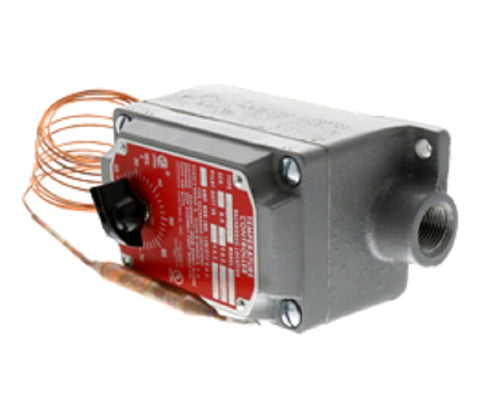
Johnson Controls A19AUC-2 Temperature Control
Temperature, Mechanical, 24 to 277Vac, SPDT, Automatic Reset, 20 to 80 degree F Setpoint Range, 3.5 degree F Fixed Differential, 6' Capillary Length with 3/8" x 4 1/16" Sensing Bulb, Hazardous Location Explosion Proof Remote Bulb Temperature Control with Knob Range Adjuster (Class I, Group D-NEMA 7 and Class II, Groups E, F, and G-NEMA 9)
Johnson Controls A19AUC-2 Temperature Control – 20 to 80°F, SPDT, Explosion-Proof
The Johnson Controls A19AUC-2 is a durable and precise temperature control thermostat designed for industrial and commercial applications. Featuring a 6 ft. capillary sensor, this unit ensures accurate temperature regulation across a 20°F to 80°F (-7°C to 27°C) range. It is explosion-proof (NEMA 7 & 9 rated), making it ideal for hazardous environments requiring reliable temperature monitoring.
Key Features:
✅ Wide Temperature Range – 20°F to 80°F (-7°C to 27°C)
✅ 6 Ft. Capillary Sensor – Flexible installation for remote monitoring
✅ SPDT Relay – Versatile control for heating & cooling systems
✅ Explosion-Proof Design – Class I, Division 1, Group D; Class II, Division 1, Groups E, F, G
✅ High Amperage Handling – 16A @ 120V, 8A @ 240V
✅ Durable Construction – Industrial-grade build for harsh conditions
✅ UL & CSA Approved – Ensures safety and compliance
Applications:
🔹 HVAC & Refrigeration Systems
🔹 Industrial Process Control
🔹 Hazardous Locations (Explosion-Proof Environments)
🔹 Heating & Cooling Equipment
🔹 Warehouse & Facility Temperature Monitoring
The Johnson Controls A19AUC-2 delivers precision, safety, and durability for demanding temperature control applications. Order now for a high-performance solution in industrial and commercial environments!
A19AUC-2 is identical to A19AUC-2C
This item is not eligible for free shipping.
QUESTIONS & ANSWERS
Have a Question?
Be the first to ask a question about this.
